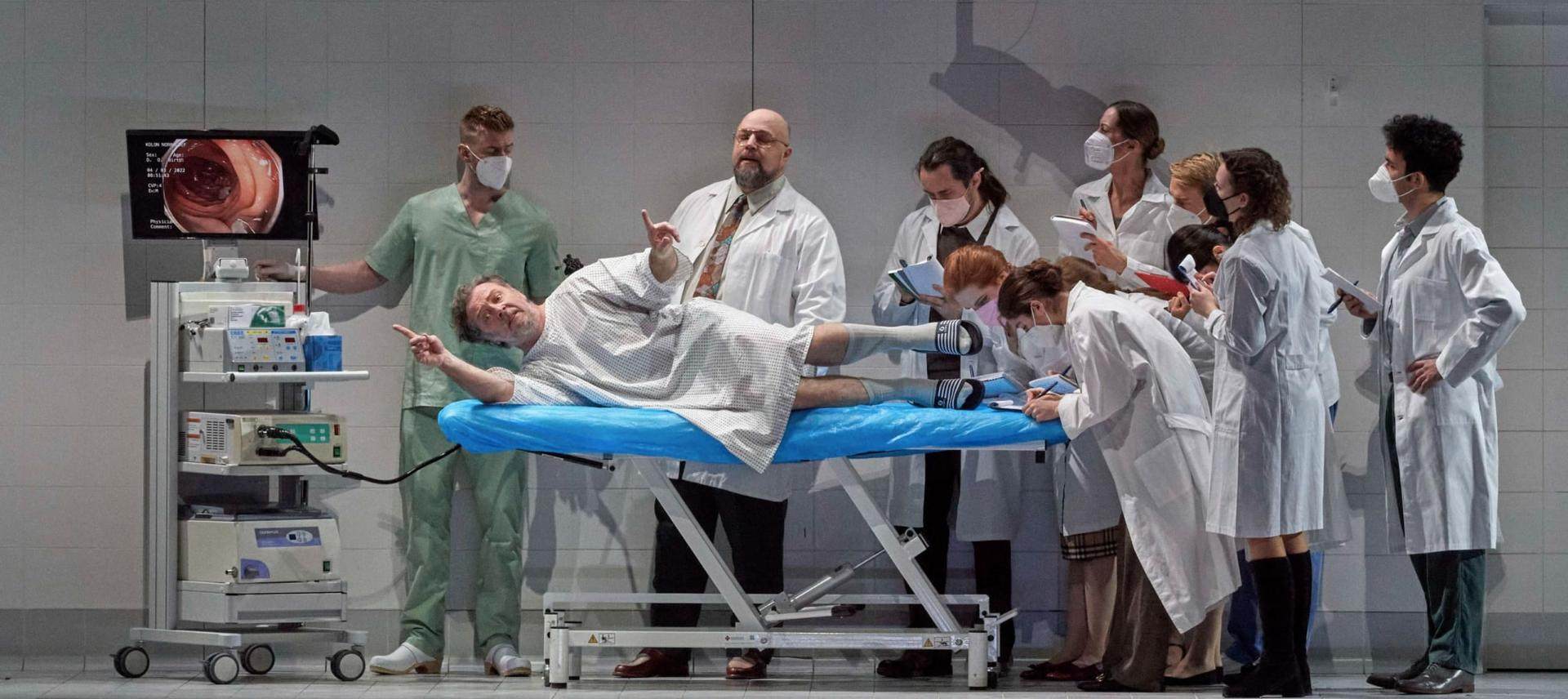Wozzeck
Mo | Tu | We | Th | Fr | Sa | Su |
Wozzeck – Alban Berg | Opera
Opera in three acts (15 scenes)
Libretto by Alban Berg
after Georg Büchner
Duration: approx. 90 minutes
Synopsis
In order to provide sufficient financial support for his girlfriend Marie and her little boy, Wozzeck pursues several different sidelines: for example, he regularly shaves the captain, cuts sticks or makes himself available to the doctor for questionable medical experiments - such as a diet of beans and pork. Restless and driven by tormenting delusions, he rushes from one activity to the next, constantly exposed to the mockery and sadism of the captain and doctor. The only support he has is his relationship with Marie. But she is attracted to the attractive drum major, with whom she eventually enters into a sexual relationship.
When Wozzeck discovers two new earrings on her, his first suspicions are aroused. But the doctor's and captain's clearly malicious insinuations also make it clear to him that he has been betrayed by Marie. When he confronts her, Marie brusquely rejects Wozzeck.
When he also sees her dancing in public with the drum major and the latter even raves to him about her physical advantages a little later, Wozzeck decides to murder Marie.
At his next encounter with Marie, outside in nature, he carries out his plan and kills Marie with a knife. Shortly after Margret and others discover blood on Wozzeck, he returns to the scene of the crime to hide the discarded knife even better, plunging deeper and deeper into the water and drowning. The boy Mariens, teased by other children, is left behind as an orphan: still too small to understand what has happened.
Program and cast
Wozzeck – Johannes Martin Kränzle
Drum Major – Dmitry Golovnin
Captain – Jörg Schneider
Doctor – Dmitry Belosselskiy
Marie – Marlis Petersen
Musical direction – Franz Welser-Möst
Production – Simon Stone
Set design – Bob Cousins
Costumes – Alice Babidge, Fauve Ryckebusch
Lighting – James Farncombe
Vienna State Opera
Public Transport
Subway lines: U1, U2, U4
Trams: 1, 2, D, J, 62, 65
Buses: 59A
Local Railway: Badner Bahn
Stops: Karlsplatz / Opera
Taxi stands are available nearby.
Parking
Parking is only € 6, - for eight hours!
The Wiener Staatsoper and the ÖPARK Kärntner Ring Garage on Mahlerstraße 8, under the “Ringstraßengalerien”, offer the patrons of the Vienna State Opera a new, reduced parking fee. You can park in the Kärntner Ring Garage for up to 8 hours and pay only a flat fee of € 6, -. Just validate your ticket at one of the discount machines inside the Wiener Staatsoper. The normal rate will be charged for parking time greater than 8 hours. The validation machines can be found at the following coat checks: Operngasse, Herbert von Karajan-Platz, and the right and left and balcony galleries.
Important: In order to get the discount, please draw a ticket and do not use your credit card when entering the garage!
After devaluing your ticket in the Wiener Staatsoper you can pay comfortably by credit card or cash at the vending machines.
The machines accept coins and bills up to 50.- Euro. Parking time longer than 8 hours will be charged at the normal rate.
History
The structure of the opera house was planned by the Viennese architect August Sicard von Sicardsburg, while the inside was designed by interior decorator Eduard van der Nüll. It was also impacted by other major artists such as Moritz von Schwind, who painted the frescoes in the foyer, and the famous "Zauberflöten" (“Magic Flute”) series of frescoes on the veranda. Neither of the architects survived to see the opening of ‘their’ opera house: the sensitive van der Nüll committed suicide, and his friend Sicardsburg died of a stroke soon afterwards.
On May 25, 1869, the opera house solemnly opened with Mozart's Don Giovanni in the presence of Emperor Franz Joseph and Empress Elisabeth.
The popularity of the building grew under the artistic influence of the first directors: Franz von Dingelstedt, Johann Herbeck, Franz Jauner, and Wilhelm Jahn. The Vienna opera experienced its first high point under the direction of Gustav Mahler. He completely transformed the outdated performance system, increased the precision and timing of the performances, and also utilized the experience of other noteworthy artists, such as Alfred Roller, for the formation of new stage aesthetics.
The years 1938 to 1945 were a dark chapter in the history of the opera house. Under the Nazis, many members of the house were driven out, pursued, and killed, and many works were not allowed to be played.
On March 12, 1945, the opera house was devastated during a bombing, but on May 1, 1945, the “State Opera in the Volksoper” opened with a performance of Mozart's THE MARRIAGE OF FIGARO. On October 6, 1945, the hastily restored “Theaters an der Wien” reopened with Beethoven's FIDELIO. For the next ten years the Vienna State Opera operated in two venues while the true headquarters was being rebuilt at a great expense.
The Secretary of State for Public Works, Julius Raab, announced on May 24, 1945, that reconstruction of the Vienna State Opera would begin immediately. Only the main facade, the grand staircase, and the Schwind Foyer had been spared from the bombs. On November 5, 1955, the Vienna State Opera reopened with a new auditorium and modernized technology. Under the direction of Karl Böhm, Beethoven’s FIDELIO was brilliantly performed, and the opening ceremonies were broadcast by Austrian television. The whole world understood that life was beginning again for this country that had just regained its independence.
Today, the Vienna State Opera is considered one of the most important opera houses in the world; in particular, it is the house with the largest repertoire. It has been under the direction of Dominique Meyer since September 1, 2010.

 EN
EN DE
DE IT
IT FR
FR ES
ES RU
RU JP
JP RO
RO
 Seating plan
Seating plan